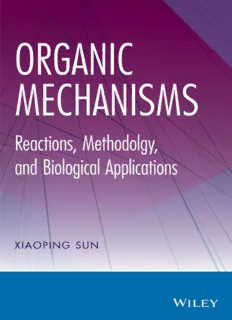
Organic mechanisms : reactions, methodology, and biological applications PDF
Preview Organic mechanisms : reactions, methodology, and biological applications
ORGANIC MECHANISMS ORGANIC MECHANISMS Reactions, Methodology, and Biological Applications XIAOPINGSUN UniversityofCharleston Charleston,WestVirginia,USA Copyright(cid:2)C 2013byJohnWiley&Sons,Inc.Allrightsreserved. PublishedbyJohnWiley&Sons,Inc.,Hoboken,NewJersey. PublishedsimultaneouslyinCanada. Nopartofthispublicationmaybereproduced,storedinaretrievalsystem,ortransmittedinanyformor byanymeans,electronic,mechanical,photocopying,recording,scanning,orotherwise,exceptas permittedunderSection107or108ofthe1976UnitedStatesCopyrightAct,withouteithertheprior writtenpermissionofthePublisher,orauthorizationthroughpaymentoftheappropriateper-copyfeeto theCopyrightClearanceCenter,Inc.,222RosewoodDrive,Danvers,MA01923,(978)750-8400, fax(978)750-4470,oronthewebatwww.copyright.com.RequeststothePublisherforpermission shouldbeaddressedtothePermissionsDepartment,JohnWiley&Sons,Inc.,111RiverStreet,Hoboken, NJ07030,(201)748-6011,fax(201)748-6008,oronlineathttp://www.wiley.com/go/permission. LimitofLiability/DisclaimerofWarranty:Whilethepublisherandauthorhaveusedtheirbesteffortsin preparingthisbook,theymakenorepresentationsorwarrantieswithrespecttotheaccuracyor completenessofthecontentsofthisbookandspecificallydisclaimanyimpliedwarrantiesof merchantabilityorfitnessforaparticularpurpose.Nowarrantymaybecreatedorextendedbysales representativesorwrittensalesmaterials.Theadviceandstrategiescontainedhereinmaynotbesuitable foryoursituation.Youshouldconsultwithaprofessionalwhereappropriate.Neitherthepublishernor authorshallbeliableforanylossofprofitoranyothercommercialdamages,includingbutnotlimitedto special,incidental,consequential,orotherdamages. Forgeneralinformationonourotherproductsandservicesorfortechnicalsupport,pleasecontactour CustomerCareDepartmentwithintheUnitedStatesat(800)762-2974,outsidetheUnitedStatesat (317)572-3993orfax(317)572-4002. Wileyalsopublishesitsbooksinavarietyofelectronicformats.Somecontentthatappearsinprintmay notbeavailableinelectronicformats.FormoreinformationaboutWileyproducts,visitourwebsiteat www.wiley.com. LibraryofCongressCataloging-in-PublicationData: Sun,Xiaoping,1960– Organicmechanisms:reactions,methodology,andbiologicalapplications/XiaopingSun, UniversityofCharleston,Charleston,WestVirginia,USA. pagescm Includesbibliographicalreferencesandindex. ISBN978-1-118-06564-8(hardback) 1.Organicreactionmechanisms. I.Title. QD502.5.S862013 547(cid:3).139–dc23 2013002855 PrintedintheUnitedStatesofAmerica ISBN:9781118065648 10 9 8 7 6 5 4 3 2 1 CONTENTS Preface xiii 1 FundamentalPrinciples 1 1.1 ReactionMechanismsandtheirImportance 1 1.2 Elementary(Concerted)andStepwiseReactions 2 1.3 Molecularity 4 1.3.1 UnimolecularReactions 4 1.3.2 BimolecularReactions 4 1.4 Kinetics 5 1.4.1 RateLawsforElementary(Concerted)Reactions 5 1.4.2 ReactiveIntermediatesandtheSteady-StateAssumption 9 1.4.3 RateLawsforStepwiseReactions 12 1.5 Thermodynamics 13 1.5.1 Enthalpy,Entropy,andFreeEnergy 13 1.5.2 ReversibleandIrreversibleReactions 14 1.5.3 ChemicalEquilibrium 15 1.6 TheTransitionState 17 1.7 TheMolecularOrbitalTheory 19 1.7.1 FormationofMolecularOrbitalsfromAtomicOrbitals 19 1.7.2 MolecularOrbitalDiagrams 25 1.7.3 ResonanceStabilization 25 1.7.4 FrontierMolecularOrbitals 28 1.8 Electrophiles/NucleophilesversusAcids/Bases 29 1.8.1 CommonElectrophiles 29 1.8.2 CommonNucleophiles 33 v vi CONTENTS 1.9 IsotopeLabeling 35 Problems 38 References 40 2 TheAliphaticC HBondFunctionalization 41 2.1 AlkylRadicals:BondingandtheirRelativeStability 42 2.2 RadicalHalogenationsoftheC HBondsonsp3-Hybridized Carbons:MechanismandNatureoftheTransitionStates 47 2.3 EnergeticsoftheRadicalHalogenationsofAlkanesandtheir Regioselectivity 51 2.3.1 EnergyProfilesforRadicalHalogenationReactions ofAlkanes 51 2.3.2 RegioselectivityforRadicalHalogenationReactions 52 2.4 KineticsofRadicalHalogenationsofAlkanes 56 2.5 RadicalInitiators 61 2.6 Transition-Metal-Compounds-CatalyzedAlkaneC HBond ActivationandFunctionalization 64 2.6.1 TheC HBondActivationviaAgosticBond 64 2.6.2 MechanismsfortheC HBondOxidative Functionalization 65 2.7 Superacids-CatalyzedAlkaneC HBondActivationand Functionalization 68 2.8 NitrationofAliphaticC HBondsviatheNitroniumNO +Ion 69 2 2.9 Enzyme-CatalyzedAlkaneC HBondActivationand Functionalization:BiochemicalMethods 71 Problems 75 References 77 3 FunctionalizationoftheAlkeneC CBondby ElectrophilicAdditions 78 3.1 MarkovnikovAdditionsviaIntermediateCarbocations 79 3.1.1 AdditionsofAlkenestoHydrogenHalides (HCl,HBr,andHI):Mechanism,Regiochemistry, andStereochemistry 79 3.1.2 Acid-andTransition-Metal-CatalyzedHydrationof AlkenesandItsApplications 84 3.1.3 Acid-CatalyzedAdditionsofAlcoholstoAlkenes 89 3.1.4 SpecialElectrophilicAdditionsoftheAlkeneC CBond: MechanisticandSyntheticAspects 89 3.1.5 ElectrophilicAdditiontotheC CTripleBondviaa VinylCationIntermediate 94 3.2 ElectrophilicAdditionofHydrogenHalidestoConjugatedDienes 95 3.3 Non-MarkovnikovRadicalAddition 96 CONTENTS vii 3.4 Hydroboration:Concerted,Non-Markovnikovsyn-Addition 97 3.4.1 Diborane(B H ):StructureandProperties 97 2 6 3.4.2 Concerted,Non-Markovnikovsyn-AdditionofBorane (BH )totheAlkeneC CBond:Mechanism, 3 Regiochemistry,andStereochemistry 98 3.4.3 SynthesisofSpecialHydroboratingReagents 102 3.4.4 ReactionsofAlkeneswithSpecialHydroborating Reagents:Regiochemistry,Stereochemistry,andtheir ApplicationsinChemicalSynthesis 103 3.5 Transition-Metal-CatalyzedHydrogenationoftheAlkeneC C Bond(syn-Addition) 107 3.5.1 MechanismandStereochemistry 107 3.5.2 SyntheticApplications 110 3.5.3 Biochemically-RelatedApplications:Hydrogenated Fats(Oils) 111 3.6 HalogenationoftheAlkeneC CBond(Anti-Addition): MechanismandItsStereochemistry 113 Problems 117 References 120 4 FunctionalizationoftheAlkeneC CBondby CycloadditionReactions 121 4.1 CycloadditionsoftheAlkeneC CBondtoForm Three-MemberedRings 122 4.1.1 Epoxidation 122 4.1.2 CycloadditionsviaCarbenesandRelatedSpecies 124 4.2 CycloadditionstoFormFour-MemberedRings 128 4.3 Diels–AlderCycloadditionsoftheAlkeneC CBondtoForm Six-MemberedRings 131 4.3.1 FrontierMolecularOrbitalInteractions 132 4.3.2 SubstituentEffects 135 4.3.3 OtherDiels–AlderReactions 138 4.4 1,3-DipolarCycloadditionsoftheC CandotherMultipleBonds toFormFive-MemberedRings 142 4.4.1 OxidationofAlkenesbyOzone(O )andOsmium 3 Tetraoxide(OsO )viaCycloadditions 142 4 4.4.2 CycloadditionsofNitrogen-Containing1,3-Dipoles toAlkenes 145 4.4.3 CycloadditionsofAlkenes,Alkynes,andNitrilestothe Dithionitronium(NS +)Ion:MakingCNS-Containing 2 AromaticHeterocycles 147 4.5 PericyclicReactions 154 Problems 158 References 161 viii CONTENTS 5 TheAromaticC HBondFunctionalizationandRelatedReactions 162 5.1 AromaticNitration:AllReactionIntermediatesandFull MechanismfortheAromaticC HBondSubstitutionby Nitronium(NO +)andRelatedElectrophiles 163 2 5.1.1 Charge-TransferComplex[ArH,NO +]betweenArene 2 andNitronium 164 5.1.2 Ion-RadicalPair[ArH+(cid:2),NO (cid:2)] 164 2 5.1.3 Arenium[Ar(H)NO ]+Ion 165 2 5.1.4 FullMechanismforAromaticNitration 166 5.2 MechanismsandSyntheticUtilityforAromaticC HBond SubstitutionsbyOtherRelatedElectrophiles 167 5.3 TheElectrophilicAromaticC HBondSubstitutionReactions viaS 1andS 2Mechanisms 174 N N 5.3.1 ReactionsInvolvingS 1Steps 175 N 5.3.2 ReactionsInvolvingS 2Steps 179 N 5.4 SubstituentEffectsontheElectrophilicAromatic SubstitutionReactions 181 5.4.1 Ortho-andPara-Directors 183 5.4.2 Meta-Directors 185 5.5 IsomerizationsEffectedbytheElectrophilicAromatic SubstitutionReactions 187 5.6 ElectrophilicSubstitutionReactionsontheAromatic Carbon–MetalBonds:MechanismsandSyntheticApplications 191 5.7 NucleophilicAromaticSubstitutionviaaBenzyne(aryne) Intermediate:FunctionalGroupTransformationson AromaticRings 193 5.8 NucleophilicAromaticSubstitutionviaanAnionic MeisenheimerComplex 197 5.9 BiologicalApplicationsofFunctionalizedAromaticCompounds 200 Problems 204 References 207 6 NucleophilicSubstitutionsonsp3-HybridizedCarbons:Functional GroupTransformations 209 6.1 NucleophilicSubstitutiononMono-Functionalized sp3-HybridizedCarbon 209 6.2 FunctionalGroupswhichareGoodandPoorLeavingGroups 211 6.3 GoodandPoorNucleophiles 213 6.4 S 2Reactions:Kinetics,Mechanism,andStereochemistry 215 N 6.4.1 MechanismandStereochemistryforS 2Reactions 215 N 6.4.2 StericEffectonS 2Reactions 218 N 6.4.3 EffectofNucleophiles 220 6.4.4 SolventEffect 222
Description: